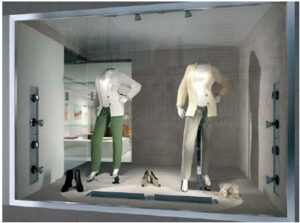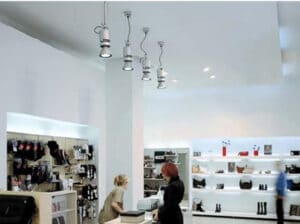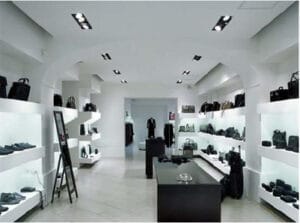Lighting of Retail Areas
Different environments have different lighting requirements. This concept is especially relevant different retail spaces.
A general rules is that discount stores, department stores, or supermarkets with large dimensions, impersonal style, inexpensive and simple products require high illumination levels ranging between 500 and 1,000 lux. This high amount of illumination must be uniform all through these stores. On the other hand small shops selling expensive and exclusive products have lower levels of illumination ranging between 100 and 250 lux. Such shops require less uniformity in the level of illumination as light in concentrated on displayed products.
When illuminating shops windows, one should attempt to increase light inside the shop window until it exceeds the light outside the outlet or else the shop window would act as a mirror to the external environment. An alternative solution would be to use a shop window that is made up of a type of glass that contains anti-reflection crystals. Such glass would also act as a barrier to UV rays that are so damaging to items displayed in shop windows.
Potential damages of displayed goods must be taken into account when designing the lighting installation of commercial spaces. The continuous exposure to light may cause undesired effects on displayed objects as fading of superficial structures, weakening of constituent structures (as fabric and paper) and dehydration (as vegetables and foods). Attention needs to be paid to not exceeding the maximum amount of exposure which particular materials can tolerate without them being damaged. For example, clothing should not be exposed to 50 lux for more than 150,000 lux hours per year.
The types of light fittings used to light different commercial spaces depend also on the area of a shop being lit. For example, for clothing fluorescent lamps are used for basic lighting, shelves and display units. Spotlights with halogen lamps are used for internal fitting rooms while spotlights with metal halide lamps are used for shop windows.
The colour temperature value depends on the atmosphere to be created in the setting. For example, sports articles would need a colour temperature of 4000K. Thus fluorescent lamps or metal halide lamps with UV filters would be best for such shops. Metal halides with a colour temperature superior to 4500K are also suitable for perfumeries and jewellery shop since the accentuation of colder colours give a feeling of cleanliness. On the other hand footwear and leather items should be lit up with a warmer type of colour temperature of about 3000K. Also wine cellars need a warm colour temperature (2,700K) in order to reproduce the cosy atmosphere of a cellar.
A final note regarding fitting rooms. Fitting rooms have now become the main attraction towards shopping in shops rather than online. Therefore, it is important that retailers give their maximum attention towards a fitting room which enhances sales. Lighting is of vital importance to achieve this. The use of warm colour temperature will enhance all skin tones. No one wants to look sick in a new dress or suit but wants an instant image enhancement upon wearing the new garment. If the beam of light is too narrow, then the harsh light will emphasise any facial lines. Again no one wants to remember about unwanted wrinkles in a new garment




